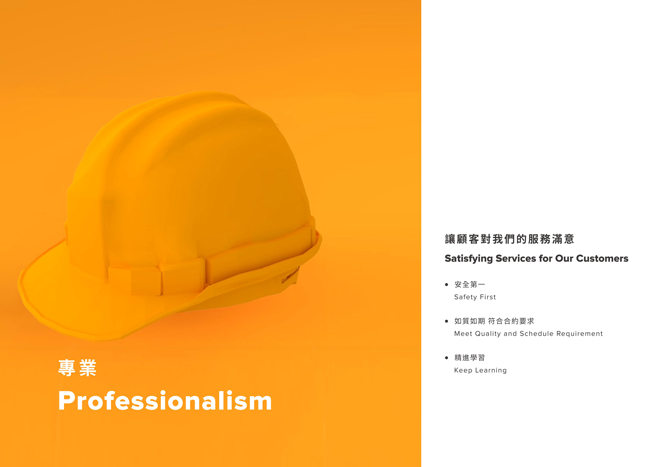Sustainable Future
永續未來
CTCI Safety Culture : A Basis of Sustainable Development
CTCI’s corporate culture is established on the four pillars of professionalism, integrity, teamwork, and innovation. This professionalism enables us to provide services that satisfy our customers and that are based on a safety-first culture. This is the foundation on which CTCI has become a trusted and reliable global engineering services provider.
CTCI has long been focused on establishing a comprehensive health, safety, and environment (HSE) management system, including promoting occupational health self-management, implementing risk management, preventing occupational injuries, and reducing environmental pollution, as part of our dedication to providing a safe and healthy work environment. In doing so, we have joined companies all over the globe in adopting the 17 Sustainable Development Goals (SDGs) defined by the United Nations. For CTCI, our safety-first culture has been guided by one of the targets of Goal 8, “Protect labour rights and promote safe and secure working environments for all workers, including migrant workers, in particular women migrants, and those in precarious employment ,” which we have sought to realize with concrete actions.

Figure 1. Sustainable Development Goals Source: Sustainable Development Knowledge Platform
CTCI Safety Culture: Sustainable Actions
1. A Deep-Rooted Commitment to Safety
According to the U.K.’s Health and Safety Laboratory, “Safety culture is a combination of the attitudes, values and perceptions that influence how something is actually done in the workplace, rather than how it should be done.” From this, we may say that the level of an organization’s safety culture can directly affect its safety performance. CTCI’s brand value has for years been based on four pillars: professionalism, integrity, teamwork, and innovation. To promote our corporate culture, we held a series of activities last year as part of the Culture Follow Me initiative. Through these efforts, the meaning of each value has been defined and the behavior that colleagues should display in accordance with each value has been illustrated, allowing them to understand CTCI’s brand value in a practical manner. Adopting a safety-first approach is an example of the type of behavior that staff should adopt in accordance with the value of professionalism. We hope that all colleagues can clearly understand that safety is a value CTCI recognizes and pursues, and that everything they do should reflect this value, which has even been listed as a criterion in our annual performance appraisal.

Figure 2. Always being safety-first is deeply rooted in CTCI’s corporate culture.
CTCI Safety Culture: Sustainable Actions
2. Safety Management Led by Senior Executives
For years, our HSE policy has been signed off on by the company president and the heads of all business units. Furthermore, CTCI’s top management holds annual management review meetings to review the results of HSE activities and overall HSE performance, and receives company-wide updates in weekly reports from the HSE Management Department to give directives or convene meetings to discuss important issues as needed. Moreover, because job-site personnel face the highest safety risks of all CTCI employees, top management visits project sites for inspection whenever necessary. The company’s HSE policy is also posted on its corporate website as well as all project sites to ensure easy access by both internal and external stakeholders.
CTCI Safety Culture: Sustainable Actions
3. Total HSE
At CTCI, responsibility for safety-related matters is clearly delineated in the company’s HSE management manual and HSE-related procedures. Project-site safety rewards as well as penalties for HSE incidents are also clarified. We further ensure clearly defined safety management through online announcements, training courses, audit activities, and online tests. Through the Total HSE Evaluation online test, we raise employees’ safety awareness and make sure they are familiar with their HSE responsibilities and the company’s related regulations. Separate versions of Total HSE Evaluation have been developed for various positions, including managers; managers in each project discipline (engineering, procurement, construction, and commissioning); site supervision staff; and general staff (further divided into HQ and project sites). This ensures that all colleagues understand their responsibilities and duties.
CTCI Safety Culture: Sustainable Actions
4. Integrating Safety into Operations
CTCI’s major operation activities span engineering, procurement, construction, and commissioning, and are executed on a project-by-project basis. Accordingly, we request that all projects conduct HSE risk assessments within a certain period of being formed and develop control measures corresponding to the level of the risks identified. Furthermore, HSE issues are included in the agenda of projects’ regularly convened internal meetings. Given that unsafe behavior is one of the main causes of HSE incidents, CTCI has promoted a behavior-based safety (BBS) management mechanism since 1999. In accordance with the company’s BBS management procedure, project sites record unsafe behaviors observed and reported by front-line workers, analyse the cause of the behaviors, and develop improvement measures to prevent them. To further raise employees’ safety awareness, the company has since last year requested that all meetings held by colleagues take time to share HSE-related knowledge, news, or personal experiences, thereby helping to internalize safety awareness and promote safe conduct.
CTCI Safety Culture: Sustainable Actions
5.Promoting Innovative Safety Management Measures
CTCI is dedicated to continuous learning in safety management. In addition to offering internal and external training to employees, CTCI has cooperated with academic institutions to promote Industry 4.0 and study feasibility of application of innovative safety management measures such as installing electric fences at construction sites, using drones to inspect confined spaces, and optimizing mobile systems at construction sites. Furthermore, external experts are invited to project sites to conduct regular HSE assessments, during which they walk through the sites with site personnel and suggest practical improvement measures. We are also working with external experts to analyze HSE incidents that have occurred in recent years to conclude their root causes and further develop CTCI’s Life-Saving Rules, which are promoted across all project sites. We also learn from experience not only by producing investigation reports for HSE incidents, but conducting investigations when an abnormality occurs in design output, with “lesson learned” reports produced as well. Furthermore, after a project is completed, the team responsible produces a project close-out report to share its members’ experiences. CTCI has integrated a safety-first culture into its operations; from the top management to entry-level employees, all staff are engaged in building a safe and secure working environment, ensuring the safety of our colleagues and a sustainable CTCI.
